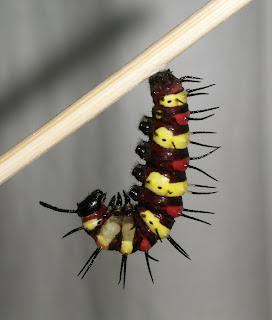The Leopard, Phalanta phalantha phalantha, is quite a common butterfly in Singapore. It is often found in parks and gardens on sunny days where its host plant, the Weeping Willow(Salix), is planted. The Leopard is usually spotted flying around weeping willows and nectaring on lantana and ixora.

Young caterpillar. Note the numerous black branching spines.
Last instar caterpillar.
Pre-pupa. The caterpillar has taken the colour of the chrysalis.
The chrysalis. Coloured a beautiful pale green and edged with silver and shining red, it looks like an exquisite piece of jewellery. It can be surprisingly difficult to spot on the undersides of willow leaves where it is usually attached. The chrysalis becomes transparent to show the butterfly within just before its emergence.
Freshly hatched Leopard. The butterfly is coloured a rich orange brown above with many black spots and lines. The undersides of fresh specimens are particularly beautiful, shaded delicately with rosy purple.






































